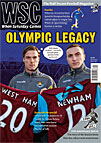 Adam Brown looks at how the political interaction of fan culture has developed since the disenfranchisement of the mid-1980s
Adam Brown looks at how the political interaction of fan culture has developed since the disenfranchisement of the mid-1980s
The year 1985 was a nadir for English football in a decade of great change for football supporters in Britain. And May was the pit of the trough. Supporters were caged in decrepit stadiums and 56 of them died in a fire at Bradford City’s ground on May 11. Violence was rife at home and abroad, policing was brutal and on the same day a 14-year-old was killed during fighting between Leeds and Birmingham fans and police at St Andrew’s. Just over two weeks later, these two factors came together killing 39 and injuring 600 at Heysel.
Events such as these fuelled a universal media portrayal of English football supporters as a problem to be contained – by electric fences in the opinion of Ken Bates, or by being birched according to others. Margaret Thatcher’s government soon introduced the Football Spectators Bill and proposed a universal ID card system for fans. Of course, none of this could happen without a response from the vast majority of supporters themselves. Organisationally this was manifested in the Football Supporters’ Association. Formed in the wreckage of Heysel, it set out to stand up for football fans and campaign for change in the way the game was run and policed.
The FSA was a real contrast to the more traditional National Federation of Football Supporters’ Clubs. Media savvy and articulate, allowing individual fans to join without being members of their official (often conservative) club organisations and overtly campaigning, going on the front foot over the inquest into Heysel. It was a modern protest organisation and it really came into its own leading the opposition to Thatcher’s ID card scheme and campaigning for justice in the aftermath of Hillsborough. It also pioneered fan embassies at the World Cup in Italy in 1990, a practice that is now commonplace at major tournaments.
The shift from 1985 onwards came in the form of the football fanzines which presented a completely different image of supporters to the mainstream media. Fan culture also began to change. Although the “ecstasy on the terraces” line has perhaps been over-emphasised at times, there were direct links between some fan groupings and the acid house scene. Alongside this was what academic Steve Redhead called a “musicalisation” of the stadium, with popular music fashion influencing terrace style and vice versa.
Together all these factors formed a successful cultural and organisational challenge by fans to the dominant discourse of “supporter-as-thug” and the ID card scheme was dropped as Thatcher left power. The Italia 90 World Cup is now held up as the watershed, transforming the image of England football fans to the soundtrack of “Let’s all have a disco”. The following year, Man Utd’s blissed-out visit to Rotterdam for the Cup-Winners Cup final helped to seal English clubs’ trouble-free return to European football. However, the roots lay firmly in 1985.
This halcyon period wouldn’t last, of course. The formation of the Premier League, the introduction of Sky and all-seat stadiums ushered in a new über-commercialised era for football. Ticket prices rocketed (with a rise of over 350 per cent between 1992 and 1999) and clubs lower down the leagues faced harsh economic realities – over 60 have gone into administration since.
While the FSA campaigned at a national level it didn’t have a club-based structure. The main loyalty of fans remained with their clubs, however, so it was inevitable that these changes brought a new generation of club-based independent supporters’ associations (ISAs). At Arsenal and West Ham the ISAs successfully defeated the hated “bond schemes”. At Spurs and Southampton the reigns of hated owners were challenged. And, by 1999, the Independent Manchester United Supporters’ Association successfully fought BSkyB’s takeover of their club.
The three-way split of FSA, the National Federation and ISAs was never going to be sustainable or most effective, and they came together in the Football Supporters’ Federation (FSF) in 2002 to speak with one voice. The FSF now represent over 150,000 supporters and receive significant funding from both football and government. Alongside this, Supporters Direct emerged from the government’s Football Task Force in 2000 helping over 150 trusts to form, 110 with shareholdings and 26 clubs in the UK to become fan owned. The current Select Committee inquiry into football’s governance received over 50 submissions from fan organisations, clubs and trusts – almost unthinkable in the mid-1980s.
Of course the battle for control of football is far from won and mainstream football supporter culture has arguably regressed to a much more sanitised, celebrity-focused, success-oriented consumerism. Recent contributions to the club ownership debate – with even Guardian journalists suggesting supporters have no right to have a role in running their clubs – show that there’s plenty of work still to be done.
From WSC 290 April 2011